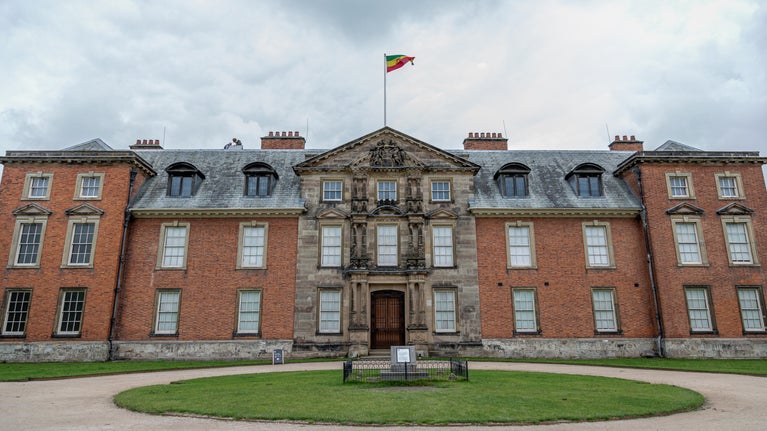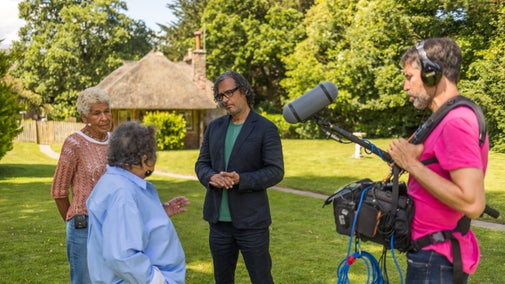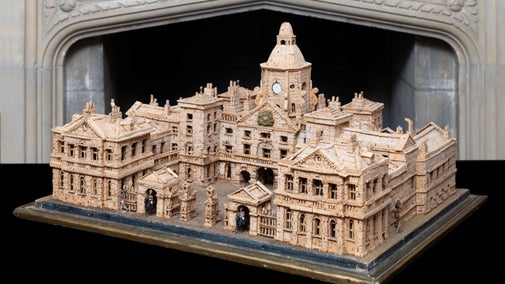
People in history
Discover some of the social history behind the places we care for and uncover fascinating facts about the people who have lived in them.

Black people connected to the places and collections we care for have shaped global history, inspiring future generations' creativity. Find out more about the people and stories behind these connections, including a Birmingham businessman, an African American artist and an exiled emperor.
Haile Selassie, Emperor of Ethiopia from 1930 to 1974, stayed at Dunham Massey in Greater Manchester for four days during his five-year exile in England. Roger Grey, the 10th Earl of Stamford who lived at Dunham Massey, began the tradition of flying the Ethiopian flag every year on Selassie’s birthday, 23 July. The Lion of Judah flag is still flown each year as a mark of respect for the friendship between the two men. The pair also exchanged letters and gifts following Selassie’s visit, which included a ceremonial shield that is on display in the Green Silk Room.
Khadambi Asalache was a poet, novelist, philosopher of mathematics and British civil servant. He was born in Kenya in 1935 and bought 575 Wandsworth Road, London, in 1981. Asalache spent 19 years decorating its interiors with hand-carved fretwork patterns and painted motifs inspired by traditional African houses and Moorish and Ottoman architecture. Today, 575 Wandsworth Road has become a source of inspiration for collaborators and creatives of all ages, forging social connections within its community and beyond.
The painting Seated Man in a Landscape at Belton House in Lincolnshire has recently been attributed to African American artist Richmond Barthé. Barthé became a critically acclaimed sculptor in New York during the 1930s and 40s. He socialised with artists, writers and thinkers of the Harlem Renaissance, one of the most powerful Black cultural movements of the 20th century. Over his career he won high-profile public commissions, prestigious art fellowships and his sculptures were collected by major museums.

George Saunders moved to the UK from the Caribbean in 1958 as part of the Windrush generation that helped fill the country’s labour shortage after the Second World War. He encountered racism and hostility, and despite being a fully-qualified tailor, he received a hostile welcome and struggled to find work. In 1974, he took over 57 Hurst Street in Birmingham and his business quickly expanded from one unit to three. He made clothes for everyone from local celebrities to Libyan schoolchildren and the Queen’s Guard. After he retired in 2001, he worked with the Trust to preserve his shop along with his equipment.
Unusual for its time, this portrait depicts a Black servant – not as an attendant to a named white sitter, but as a subject in his own right. It was added to the collection of Philip Yorke (1743–1804) as part of a group of servant portraits at Erddig in Wrexham in the late 18th century. The text in the top corner, added by Yorke to the painting, details the hardships of a Black servant in the Erddig household 70 years earlier and the influence of William Wilberforce for challenging the transatlantic trade in enslaved people.

Born in Jamaica when slavery was still legal, Mary Sarah Oates was the daughter of Margaret Cross, a free woman, and George Hibbert Oates, a British plantation manager. Mary was sent to live with her paternal grandmother and aunt in Bath, where she started school in 1840. In 1876, Mary married the executor of her aunt’s estate, Reverend Wynter Thomas Blathwayt. They lived in Dyrham Park in South Gloucestershire from 1899 when he inherited the estate – making Mary the lady of the house.
Mary Prince was the first Black woman to publish a first-hand account of slavery in the British colonies in 1831 and to present an anti-slavery petition to Parliament in 1828. Her account, The History of Mary Prince: A West Indian Slave, galvanised the abolition movement in Britain. Prince’s name accompanies a portrait of Phyllis Wheatley, the first published African American woman, in Hew Locke’s The Jurors, a permanent artwork of 12 intricate bronze chairs at Runnymede.
David Miller Jr is best known for his series of sculpted heads. Miller and his father, David Miller Sr, began their careers by creating curios and carvings to supply the tourist industry in Jamaica. From the 1940s they both began to carve in a more three-dimensional mode and became increasingly recognised for their individual contributions to modern Jamaican art. Walter McGeough Bond, the last owner of The Argory in Northern Ireland, acquired Miller Jr's Head No. 4 in Jamaica and gave it to the National Trust in 1979.

Discover some of the social history behind the places we care for and uncover fascinating facts about the people who have lived in them.
Historian David Olusoga tells the story of the children born to white British mothers and black American GIs during the Second World War, dubbed Britain's 'Brown Babies' in the African American press at the time. David joins Carol and Ann as they revisit their childhood home, Holnicote House in Somerset, which was used to care for around 30 'Brown Babies' during the 1940s.

Learn more about the collection of paintings, decorative art, costume, books, household and other objects at historic places in our care.

Read our report on colonialism and historic slavery in the places and collections we care for and discover how we’re changing the way we approach these issues.

We're committed to meeting the needs and expectations of a diverse society. Find out what we're doing to create an inclusive, accessible and welcoming environment for our supporters, staff and volunteers.
